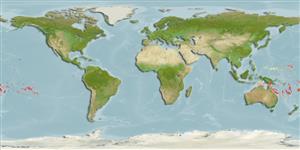>
Eupercaria/misc (Various families in series Eupercaria) >
Labridae (Wrasses) > Corinae
Etymology: Pseudojuloides: Greek, pseudes = false + Greek, iouis = a fish without identification, perhaps some of genus Coris cited by Plinius + Greek, oides = similar to (Ref. 45335); atavai: Name from Tahitian word 'atavai' meaning pretty, referring to the attractive coloration of both sexes of the species.
Eponymy: Not an eponym but from the Tahitian word for ‘pretty’. (Ref. 128868), visit book page.
More on authors: Randall & Randall.
Environment: milieu / climate zone / depth range / distribution range
Ecologia
marino associati a barriera corallina; distribuzione batimetrica 12 - 31 m (Ref. 1602). Tropical; 14°N - 28°S
Pacific Ocean: Guam to the Society, Tuamoto, Austral and Ducie islands.
Size / Peso / Age
Maturity: Lm ? range ? - ? cm
Max length : 13.0 cm TL maschio/sesso non determinato; (Ref. 9710)
Spine dorsali (totale) : 9; Raggi dorsali molli (totale) : 11; Spine anali: 3; Raggi anali molli: 12; Vertebre: 25. This species is distinguished from its congeners by the following characters: body elongate with greatest body depth 22.6-25.3% SL; D IX,11; A III,12; pectoral-fin rays 13; tubed lateral-line scales 28. Colouration: interspinous membrane between anterior two to three spines of dorsal fin has a black spot; males with head yellow and extensively reticulate; abdominal region behind pelvic and pectoral fins is orange to orange-pink with yellow crosshatch markings; posterior part of body purple black; females are distinctly bicolored, orange-brown dorsally, white ventrally (Ref. 123182).
Found well above the bottom of exposed seaward reefs (Ref. 9710) away from lagoons and sheltered bays (Ref. 123182). Feeds on small invertebrates (Ref. 89972).
Life cycle and mating behavior
Maturità | Riproduzione | Deposizione | Uova | Fecundity | Larve
Oviparous, distinct pairing during breeding (Ref. 205).
Randall, J.E. and H.A. Randall, 1981. A revision of the labrid fish genus Pseudojuloides, with descriptions of five new species. Pac. Sci. 35(1):51-74. (Ref. 2140)
IUCN Red List Status (Ref. 130435: Version 2024-2)
Threat to humans
Harmless
Human uses
Strumenti
Special reports
Download XML
Fonti Internet
Estimates based on models
Preferred temperature (Ref.
123201): 24.7 - 26.3, mean 26.1 °C (based on 12 cells).
Phylogenetic diversity index (Ref.
82804): PD
50 = 0.5000 [Uniqueness, from 0.5 = low to 2.0 = high].
Bayesian length-weight: a=0.00977 (0.00466 - 0.02049), b=3.07 (2.90 - 3.24), in cm total length, based on LWR estimates for this (Sub)family-body shape (Ref.
93245).
Trophic level (Ref.
69278): 3.4 ±0.4 se; based on size and trophs of closest relatives
Resilienza (Ref.
120179): Alto, tempo minimo di raddoppiamento della popolazione meno di 15 mesi (Preliminary K or Fecundity.).
Fishing Vulnerability (Ref.
59153): Low vulnerability (10 of 100).
Nutrients (Ref.
124155): Calcium = 95.7 [56.8, 165.3] mg/100g; Iron = 0.759 [0.442, 1.405] mg/100g; Protein = 18.5 [15.6, 20.7] %; Omega3 = 0.163 [0.103, 0.261] g/100g; Selenium = 23 [13, 42] μg/100g; VitaminA = 151 [47, 567] μg/100g; Zinc = 1.77 [1.20, 2.76] mg/100g (wet weight);
